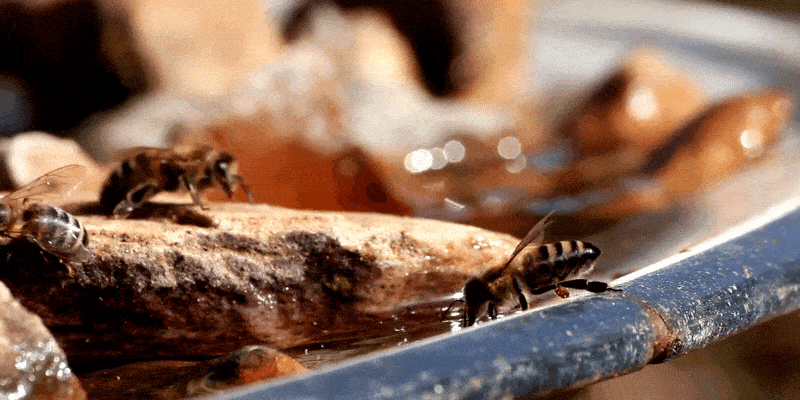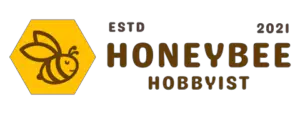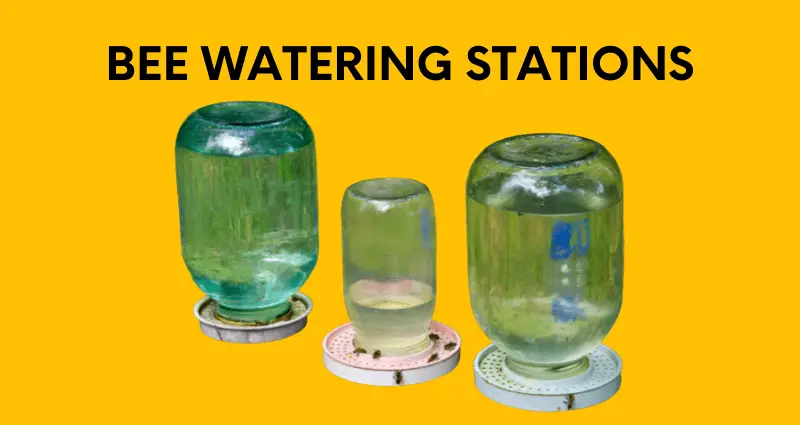Imagine drinking a glass of water on a hot day.
The feeling of relief after the water reaches your belly. Or the cool sensation across your lips.
Bees, like every other animal, feel the same when they have access to a safe, reliable water source. And it’s important for beekeepers to provide a watering hole for their bee colony.
Luckily, you don’t need a refrigerator or ice cubes to satisfy bees. A simple DIY watering station like a birdbath or a water feeder is enough to satisfy these little pollinators.
In this guide, we’ll walk you through how to build a bee watering station and what to keep in mind while doing so.
Let’s get started.
What Is A Bee Watering Station?
A bee watering station is a source of drinking water that helps keep bees hydrated and cool. From small bowls, terra cotta pots, birdbaths, or even backyard pools, there are many different types of watering stations a beekeeper may consider.

Why Do Honey Bees Need Water?
- Bees drink water as they get thirsty like any other animal. Other than the need to hydrate, here are a few reasons bees need a constant fresh water source.
- Honey bees collect and take water back to the hive, but don’t store it inside it. Some bees work as mini water tanks. They move around the hive with their stomach full of water. House bees use this water as needed
- On hot summer days, bees place water droplets along the surface of the honeycomb and then fan the comb with their wings. This air conditioning effect will help keep the colony, including the baby bees, cool.
- Among other food, bees eat their own honey. Sometimes honey can get too thick. Bees use water to dilute the honey
- In the winter, they also use water to dissolve crystallized honey and make it drinkable
Do Bees Even Need Your Watering Station?
Ok, so bees need water, but do they need a unique water station from their beekeeper? Can’t they just collect it naturally from a river or a pond?
Of course, they can. Bees have fantastic instincts when it comes to developing the perfect bee habitat.
But, all beehives aren’t near a proper natural source of water. In these cases, the bees will look elsewhere, then use the waggle dance to inform the colony of where that water source is. The bees might target a ditch or your neighbor’s pool.
Sometimes, these sources of water contain pesticides or other harmful chemicals.
Also, building a station might save you or your neighbors’ sunbathers from unfortunate encounters with the bees – and potential elimination of the hive.

3 DIY Bee Watering Station Ideas
As complex as the term bee watering station sounds – it’s pretty easy to set up. You can make yours fit your bee garden’s aesthetic, or you can make it simple and utilitarian. Once yours is made, just put it several feet away from the hive.
Here are some DIY station ideas you can check out for your yard.
1. Transform A Birdbath
Birdbaths are an excellent choice for a watering station because they are shallow. Bees can usually stand on the edge and drink or collect water. But remember, bees can’t swim – so add some small stones or corks to make a more safe place for your bees to stand on.
2. The Marble Bowl
For this one, get a shallow container or flower pot. It should be large enough to hold a few ounces of water but not so big that the bees drown. Maybe a shallow dish or a frisbee. Then buy a bag of multi-colored marbles or pebbles from a craft store. Put the marbles in the shallow bowl, and you got yourself a station. The marbles need to be colorful because bees are attracted to colorful objects.
3. The Poultry Feeder
Chicken feeders are a better choice than pet bowls because they’re more durable and don’t easily break. But just like with the previous suggestions, add a few pebbles if it’s more than a few centimeters deep.
How To Attract Bees To Your Watering Station
So, you built your honey bee watering station but bees aren’t coming to drink from it? Here are some things you can do to attract bees to your watering station.
- Even though bees have five eyes, they largely rely on their sense of smell. So, you can use scent to attract bees to your station. Add a bit of lemongrass oil or salt to help the colony find it.
- Rather than clean water, bees tend to prefer water that’s a little bit dirty and has some plant growth in it.
- If you have a vegetable garden, you can put the station near flowers honeybees like.
- You can try adding a few oyster shells to the station, which gives the water a faintly salty ocean smell.
- A teaspoon of chlorine bleach in a bucket of water also helps attract bees.
After the bees have found the water station, you can stop adding the attractant after a few days. Because after a few days, the bees will forget the smell and simply come for the water. Your goal here is to establish a pattern as early as possible.
Don’t Add Sugar Or Water
While it might seem like a smart idea – avoid adding sugar and honey to the water to attract bees.
Bees are good with directions, so if they make one stop at the station and taste sugar. They’ll be back with the gang to collect the sugar instead of collecting it from flowers.
Anything other than white sugar is detrimental to bee’s health. Also, bees can’t make honey from the sugar water and it is likely to attract ants instead.
Next comes honey. This is the more dangerous option. Honey can attract a fatal bacterium, and if a bee brings it back to the hive – it can infect the whole hive.
Just stick with clear tap water or the previously mentioned options.
Keep The Watering Station Close (But Not Too Close)
In times of scarcity, honey bees can travel up to five miles for resources. But, that is not ideal. It might end up using more resources than it collects. So, the best water source should be reasonably close to the hive.
However, too close isn’t necessarily good. Bees communicate by dancing – but the dance language isn’t very effective close range. Bees have trouble explaining things that are too near the hive. So, put a minimum distance of perhaps 100 feet between the hive and the station.


